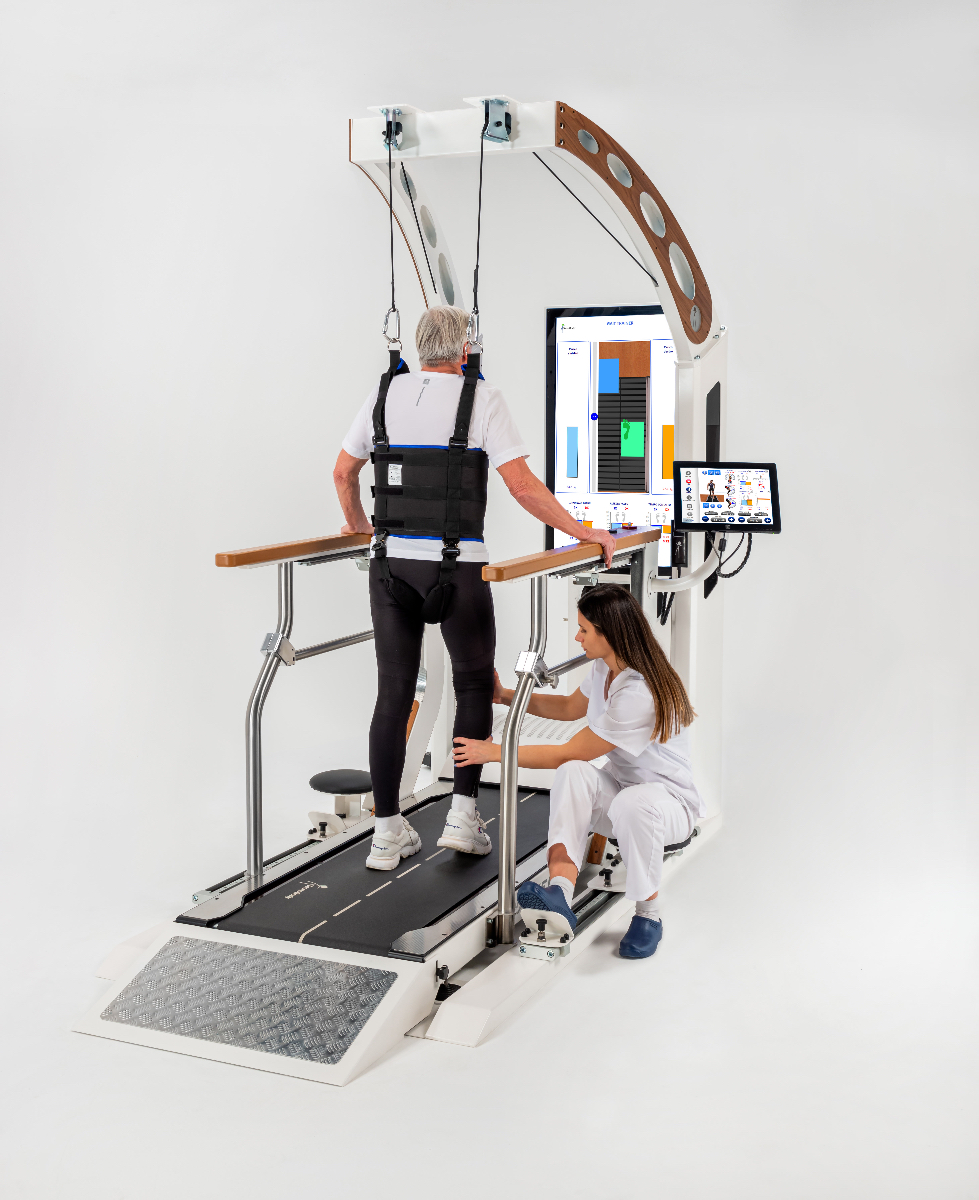The Centre
The Centre
Innovation serving humanity through advanced rehabilitation
At ARC, we believe that innovation should serve humanity. Our interdisciplinary care team includes exercise physiologists, neurologists, physiotherapists, occupational therapists, psychologists, and rehabilitation physicians who collaborate to provide a comprehensive and coordinated treatment pathway. Each program is tailored to meet the goals of the patient using the following pillars:
Neuroplasticity
Harnessing the brain's ability to form new neural connections and reorganise existing ones for optimal recovery.
Robotics
Advanced robotic systems providing precise, repeatable movements and real-time feedback for enhanced rehabilitation.
Virtual Reality (VR)
Immersive environments creating engaging and effective therapy sessions through interactive experiences.
Gamification
Motivating and engaging therapy through game-based exercises that make rehabilitation more enjoyable.
Artificial Intelligence (AI)
Smart systems that adapt and personalise treatment programs based on patient progress and needs.
Neuroplasticity
Technology
Technology in Action
Advanced rehabilitation technology for optimal recovery
Our state-of-the-art recovery centre features a therapeutic environment designed to promote engagement, comfort, and safety. It is equipped with robotic-assisted gait trainers, arm and hand exoskeletons, immersive VR systems, motion capture tools, and Tyromotion neurorehabilitation technology including AMADEO, DIEGO, and PABLO systems.
Key Benefits
- Enhanced recovery through precise, targeted therapy
- Real-time progress tracking and adaptation
- Increased patient engagement and motivation
Technology Integration
Robotics
Advanced robotic systems for precise movement therapy
VR Systems
Immersive environments for engaging therapy
Motion Capture
Precise movement analysis and tracking
Gamification
Engaging exercises for better outcomes
Our Equipment
Advanced rehabilitation equipment for optimal recovery
Amadeo

GRASP
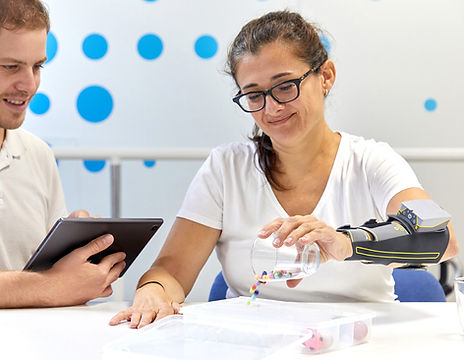
GRASP
Advanced Hand and Finger Rehabilitation
Rehabilitation Device
GRASP is a rehabilitation device based on functional electrical stimulation (FES) that generates flexion and extension of the wrist and fingers, designed for people with motor impairment of the upper extremity due to injuries or diseases of the nervous system.
High Selectivity of Movements
Wrist
Thumb
Index
Fingers 3,4,5
Functional Movements
Open hand
Pinch grasp
Palmar grasp
AMADEO
Advanced Hand and Finger Rehabilitation
AMADEO facts
- Robotics and sensor-based rehabilitation devices for use with either hand
- Assistive and interactive therapies for individual fingers and thumbs movements
- Patients can be set up quickly and easily
- Arm supports can be changed quickly
- Can be used by adults and children in all rehabilitation phases
- Can be used by patients with spasticity, or those with high tone
AMADEO functionalities
- Supports the resolution of spasticity as well as the testing of tactile sensibility
- EMG-based training enables active therapy even without muscular strength
- Passive, assistive, and active modes possible
- Offers support in just the right intensity by establishing force limits, speed and range of motion
- Adjustable to every patient: Height of the table, position of the hand unit in pronation and supination, spread of the finger movement
AMADEO in practice
- Objective assessments and reports
- 4 assessment programs (strength, ROM, tone, spasticity)
- Sensation and individual movement therapy
- CPM Plus, EMG, spasticity treatment
Regardless of whether it is an adult or child, AMADEO arouses therapeutic ambition with sophisticated robotics and a playful approach and also visualises the smallest successes in all phases of rehabilitation.
Diego

DIEGO
Advanced Upper Extremity Rehabilitation
Rehabilitation Device
DIEGO is Tyromotion's unique robotic upper extremity rehabilitation device for neurological and orthopedic conditions. DIEGO skillfully assists patients with its unique intelligent weight relief. Its 3-dimensional therapeutic area and virtual reality promotes therapy progress and allows functional training according to the individual rehabilitation goals.
DIEGO facts
- Robotic and sensor-based rehabilitation device
- Unilateral and bilateral therapy in one device – no configuration necessary
- Assistive and interactive therapies for the whole arm
- Applicable for adults and children in all rehabilitation phases
- Short setup time of patient to device
- End effector system (hands-on possible)
- Assist-as-needed with intelligent gravity compensation (IGC)
- Enables task-oriented training
DIEGO functionalities
- Training of lost arm-shoulder functionalities in neurological, pediatric, orthopedic, and geriatric impairments
- Distal support allows for a proximal initiation of movement
- Active weight relief of the arms, IGC promotes an optimal mobilization of the arms
- Virtual Reality supports cognitive rehabilitation and stimulates neuroplastic changes in the brain
- ROM assessments as well as functional therapies for the upper extremity
- Quick and easy patient setup with arm slings that attach to the arm both unilaterally and bilaterally
- Accessible for both mobile and wheelchair patients
- Two overhead arm units, individually adjustable arm slings, motor controlled ropes
- Sensors capture the arms' positions as well as the joint angle
DIEGO in practice
- Interactive therapeutic games
- Assessments show improvements and rehabilitation progression
- Reporting and documentation saves diagnoses & therapy results
- Enables ideal transfer of what the patient has learned into everyday life
- Quick change between adults and children
- High net therapy time
- Interactive therapies and task-oriented training with objects
- Symmetrical and asymmetrical movements as well as cyclical and cooperative sequences of movement
Myro

MYRO
Creative Therapy Through Interactive Technology
Real objects, power control, touch applications, and a whole lot of fun: this is what constitutes goal-oriented, intuitive therapy with MYRO. The sensor-based surface is the basis for creative therapy which brings about meaning and self-determination in daily life.
MYRO facts
- Highly adaptable
- Provides working space for more than one person
- Unilateral and bilateral training
- Can be used in combination with DIEGO
- Offers full documentation and tracking of the therapy units with TyroS software
MYRO functionalities
- Interactive applications with real objects, force control, and touch applications
- Neurology, orthopedics, geriatrics, and pediatrics
- Task-oriented rehabilitation with sensor-based surface and real objects
- Force detection with pressure and pull to assess
- Bilateral work enables a better rewiring of the hemispheres
- Trains gross-motor skills, fine-motor-skills, rotation movement, hand-eye coordination, and motoric coordination
- Especially for patients with deficits in motor function, concentration, selective attention, visual-spatial perception, and spatial-perceptive ability
MYRO in practice
- Shape recognition and reproduction
- Daily planning and routine
- Visual exploration
- Improves accuracy
- Supports creativity
- Assistive movement therapy in combination with DIEGO
- Improves motor skills and active range of motion
Pablo
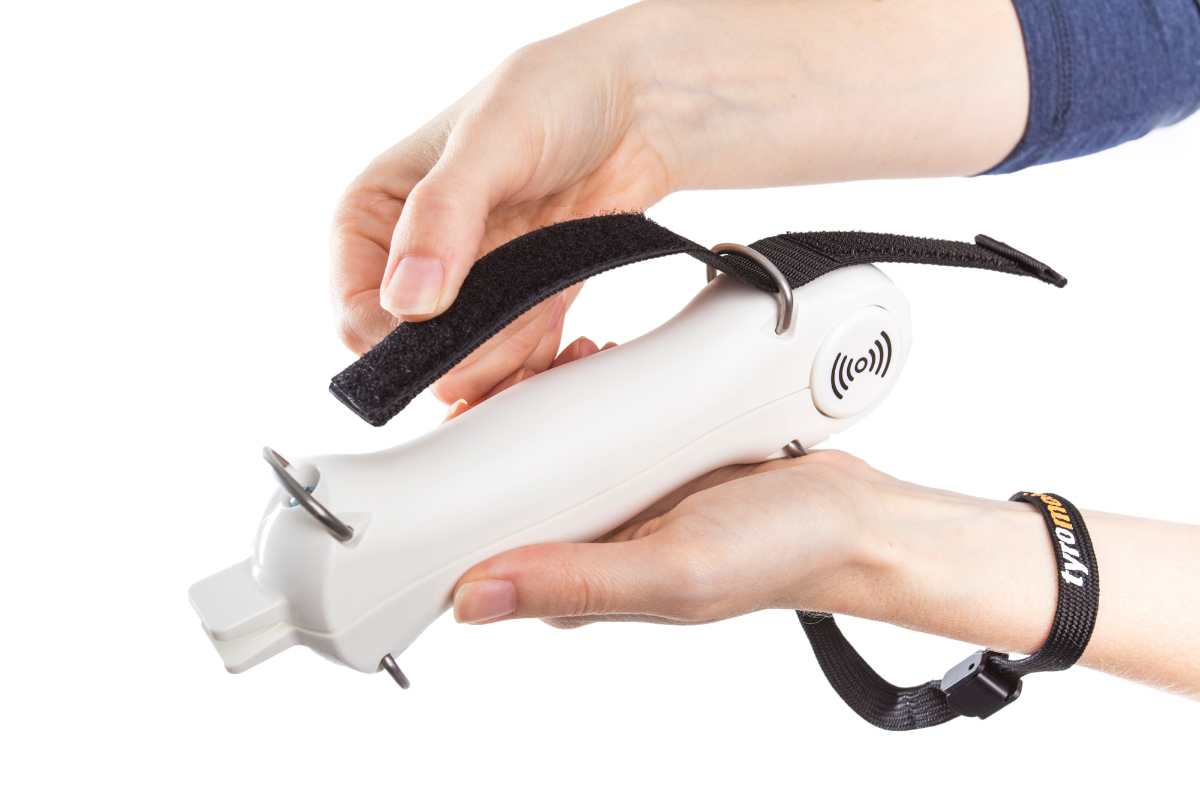
PABLO
The All-rounder for Activities of Daily Living
Therapies for hand, arm, shoulder, and trunk made simple and exciting. Position sensors and numerous accessories open up incredibly flexible therapeutic options in a safe environment for patients of all impairment levels.
PABLO facts
- Sensor-based rehabilitation device for unilateral and bilateral training
- Interactive therapies for the whole body (hand, fingers, arms, legs, trunk, head)
- Wireless therapy device
- Can be used by adults and children in all rehabilitation phases
- Objective assessments, monitoring and reporting system
- Assistance and movement guidance with Multiboard and Multiball for weaker patients
PABLO functionalities
- Measurement of various gripping patterns of the human hand and the resulting forces
- Built-in strength sensors measure extension and flexion force of the hand
- Training of pronation and supination training as well as wrist extension and flexion training
- Measurement of exerted force for pinch, lateral-, three-point- and interdigital grips
- Motion sensors with built-in Inertial Measurement Units (IMU) measure every kind of body movement (head, arm, trunk, leg)
- Ergonomic design for adults and children
- Individual positioning of Motion sensors
- Connects wirelessly via Bluetooth
- Interactive movement training with audiovisual feedback
PABLO in practice
- Endless possibilities: Combining PABLO motion sensors with the TYROS software enables various motivating therapeutic movement exercise with additional feedback
- Assessments for measuring the strength of hand functions and the active range of motion of the upper extremity
- Interactive therapy games increase motivation and ensure target-oriented repetitive therapy
- Report and documentation options: Individual data and therapy progress are documented in an electronic patient file
- Link to daily routine: Link to daily routine supports the motivation of the patient and enables motor learning
- Minimal movements become visible: The sensitivity of the motion sensors enables tracking of elemental movements
Tymo
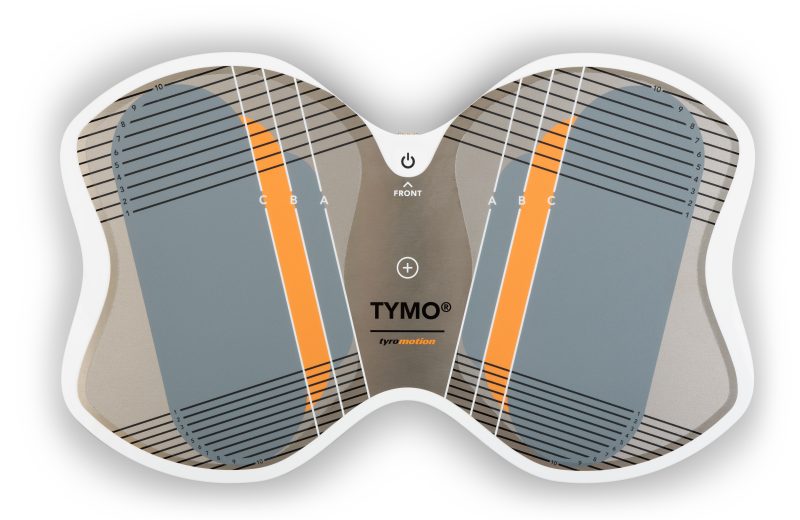
TYMO
Advanced Balance and Posture Training System
TYMO is a portable posturography system and the world's thinnest balance platform. Flexible in application, TYMO trains postural control in a sensitive, specific and meaningful manner, and is, therefore, the basis of all movements. Motivation and fun are included.
TYMO facts
- Portable and lightweight design for flexible use
- High-precision sensors for accurate balance assessment
- Interactive training with real-time feedback
- Suitable for various patient populations
- Gamified exercises for increased motivation
TYMO functionalities
- Balance assessment and training in standing and sitting positions
- Weight distribution analysis and training
- Dynamic stability exercises
- Cognitive-motor dual tasks
- Progress tracking and documentation
TYMO in practice
Clinical Applications
- Neurological rehabilitation
- Orthopedic recovery
- Geriatric balance training
- Sports rehabilitation
Training Benefits
- Improved balance control
- Enhanced postural stability
- Better weight distribution
- Increased confidence in movement
Tyrostation
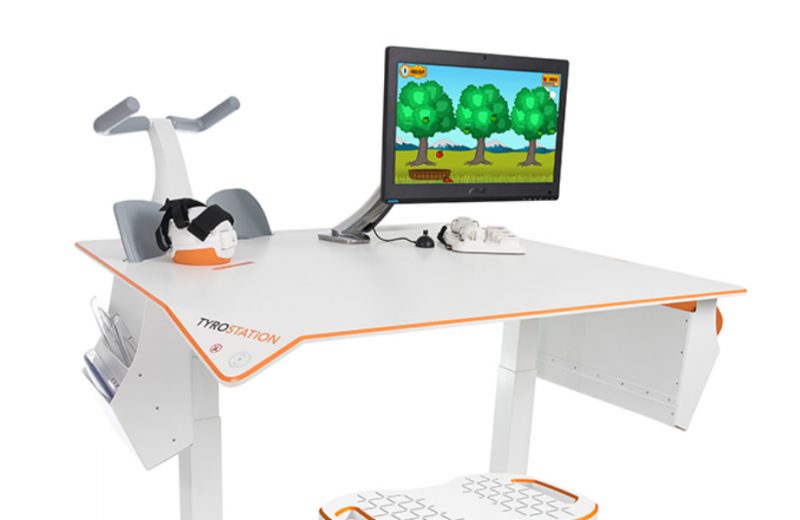
TYROSTATION
The Central Hub for PABLO and TYMO Applications
The Complete Solution
The TYROSTATION is home to all individual components of our two all-rounders, PABLO and TYMO, and also provides perfect ergonomic adaptability for every patient.
Easily adjustable for all patients
Flexible configuration options ensure optimal positioning and comfort for every user, regardless of their physical condition or requirements.
Safe storage and charging of devices
Integrated storage solutions and charging capabilities keep all components secure, organized, and ready for use.
All in one computer
Centralized computing system manages all applications and provides seamless integration of therapy components.
Therapy stool
Ergonomic seating solution designed for optimal patient positioning during therapy sessions.
Structured Environment
Provides a structured environment for all PABLO and TYMO applications, ensuring efficient and effective therapy sessions.
Organized Workspace
- Efficient arrangement of components
- Easy access to all tools
- Optimized workflow
Integration Features
- Seamless device connectivity
- Unified control interface
- Real-time data synchronization
Safety Features
- Secure component storage
- Protected charging system
- Stable platform design
D-WALL
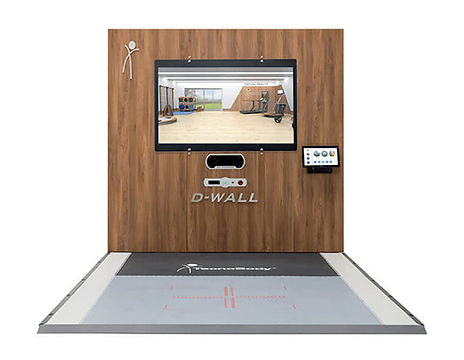
HOMING(coming in 2026)

D-WALL
The Digital Mirror Revolution in Rehabilitation
D-WALL represents the mirror revolution in gyms. The Hi-Tech digital mirror not only allows you to perform each motor gesture with maximum control, but also makes it possible to analyse the performance in real time according to precise parameters.
Thanks to D-WALL, you can perform hundreds of exercises and programs ready to use, specific for posture, functional training, balance and strength. Assessment and training can be managed in an integrated way to provide a training guide in both Rehab and Health Fitness.
3D Camera
The 3D camera, placed in front of the D-WALL system, is one of the fulcrums of the system. Thanks to the body recognition and the interface gesture, the athlete and the patient get feedback in real time on each movement performed. The classic mirror thus becomes a digital mirror capable of detecting every single gesture with precision and reliability.
Video Wall
The mirror is perhaps one of the most widespread universal elements in the Fitness and Rehab area. TecnoBody has reinvented it to create a real revolution in gyms. Immersive Virtual Reality is the protagonist of this screen, capable of giving back an immediate biofeedback that is traceable to the intuitiveness that can be found in the mirrors.
16" Touch Screen Monitor
The management of the commands can be managed simply with the recognition of gestures by the 3D camera. To start an exercise just move a hand and stop it in correspondence with the chosen key in front of you. For an integrated management by the trainer the 16" touch screen monitor allows a complete interaction with the system.
TecnoBody Key
Each athlete is unique, each patient has his own program, each has a personal TecnoBody Key. By inserting TecnoBody Key in any device of the TecnoBody line, the system recognizes the owner and automatically sets up the guided training. TecnoBody Key contains not only the training program of your patient-client but also, above all, its assessments: strength, balance, stability, elasticity, etc.
The Strength Platform
The strength platform of D-WALL H-Sport is the optional element that completes your digital mirror for an even richer assessment and training experience.
Real-time Analysis
With the strength platform you can enrich D-WALL H-Sport with a real stabilometric kit, able to return all the data inherent to the analysis of 3D movement.
Comprehensive Testing
The four load cells on the platform allow you to perform Squat Jump Test, Fitness Test and Health Test with all the precision necessary to evaluate the strength of your athlete.
Getting Started
Getting Started
Begin your rehabilitation journey with us
We'd love to help you on your rehabilitation journey!
Getting started is simple, please click and complete the form below. Once received, one of our friendly team members will be in touch to arrange your appointment.
Please note: you'll need a referral to attend our clinic.
If you don't have one yet, don’t worry! You can speak with your GP, support or community service, hospital representative, NDIS provider, or other healthcare professional to organise this.
We're here to make the process as smooth as possible and look forward to supporting you every step of the way.
Resources
Research & Resources
Evidence-based neurorehabilitation insights
Stroke
Laver KE, et al. Virtual reality for stroke rehabilitation (Cochrane Review, updated to Sept 2023 / 2025 update). Cochrane Library
Panzeri M, et al. Effectiveness and safety of VR rehab after stroke (EClinicalMedicine, 2023). The Lancet
Sale P, et al. Robot-assisted arm exercise after stroke—systematic review (GRADE) (2023). SAGE Journals
Li Z, et al. Robotic therapy after stroke—systematic review/meta-analysis, phase modifiers (2025). Frontiers
Eraifej J, et al. Upper-limb FES after stroke—systematic review/meta-analysis (2021–23). ScienceDirectFrontiers
Exergames in stroke—umbrella review (2025). ScienceDirect
AI in stroke rehab—systematic reviews/meta-analysis (2024–2025). ScienceDirectMDPI
Spinal Cord Injury
Park J-Y, et al. Robot-assisted gait training in SCI—systematic review/meta-analysis (2023). E-Arm
Xiangli J, et al. FES alone or adjunct to exercise improves respiratory/aerobic capacity in SCI—meta-analysis(2025). Frontiers
Luo B, et al. RAGT + NIBS in stroke/SCI—systematic review/meta-analysis (2023). Frontiers
Popović MR (ed.). FES therapy mechanisms and recovery in SCI/stroke (book chapters, 2022; 2016). SpringerLink
Parkinson's Disease
Kwon S-H, et al. VR in PD—systematic review/meta-analysis (NeurEng Rehabil, 2023). BioMed CentralSpringerLink
Lazzarini B, et al. Robot-assisted training in PD—systematic review/meta-analysis (J Neurol, 2025). SpringerLink
Li Y, et al. Exercise types and PD gait—network meta-analysis (2025). Frontiers
AR cueing for PD (Strolll)—translational/clinical reporting. WIRED
Complex Orthopaedic Injuries
Shaheen A, et al. VR after TKA—systematic review/meta-analysis (2025). SpringerOpenSpringerLink
XR after TKA—systematic review/meta-analysis (2024). ScienceDirect
NMES after shoulder surgery—systematic review/meta-analysis (2025). ScienceDirect
Sports Injuries
Li Y, et al. VR after ACL reconstruction—systematic review/meta-analysis (2025). Link
Shan W, et al. Electrical stimulation after ACLR—systematic review/meta-analysis (BMJ Open, 2025). Link
Exergames in ACLR rehab—systematic review (2021). ScienceDirect
Brand-specific
Fesia Walk scientific brochures and early trials/usability studies on LyncareMedical SolutionsSAGE JournalsEtran
Tyromotion evidence page and Amadeo spasticity measurement validity studies; stroke protocol updates. Frontiers/Europe PMC
Tecnobody ProKin device description, reliability, and ongoing TKA trial registration. tecnobody.com/US/RDLegalTrials
Multiple Sclerosis
Prosperini L, et al. VR/gaming improves balance and reduces falls in MS—systematic review/meta-analysis (2022). FrontiersMDPI
Burridge J, et al. Walking with FES—clinical practice guidance (JNIN conditions Rev, 2023). Frontiers
FES for MS/SCI/Stroke—recent RCTs/clinical results (2023). ScienceDirectijmsc.org
Traumatic Brain Injury
Alashram A, et al. VR for rehab in TBI—review (2024). SpringerLink
Li C, et al. VR for balance/motor post TBI—systematic review (2022). ScienceDirect
Drid P, et al. VR for cognition after brain injury—systematic review (2024). article
Buarque JC, et al. RAGT after severe TBI—feasibility protocol (BMJ Open, 2025). BMJ Open
GBS/CIDP
Rehab & NMES in GBS—textbook/chapters and pilot trials; evidence limited. ScienceDirectNature
Cerebral Palsy
Lim J-H, et al. Robot rehab effects on motor/gait in CP—meta-analysis (2024). e-article
Ziah H, et al. VR for balance in CP—systematic review/meta-analysis (2022). ResearchGate
Chen YH, et al. NMES improves mobility in CP—systematic/meta-analysis (2022). www.clinicalneurostudies.com
Tyromotion pediatric CP RCT (hand function/QoL). tyromotion
Additional Categories
Clinical Studies
Research Areas
Neuroplasticity and Rehabilitation: A Clinical Introduction
What is Neuroplasticity?
Neuroplasticity is the brain and spinal cord's remarkable ability to adapt, reorganise, and create new connections in response to learning, experience, or injury. Far from being limited to childhood, adaptive plasticity persists across the lifespan and plays a central role in recovery after neurological conditions such as stroke, traumatic brain injury, or spinal cord injury.
At its core, neuroplasticity is the foundation of rehabilitation: by engaging in targeted, meaningful, and repetitive therapy, patients can "retrain" surviving neural networks to restore function or develop compensatory pathways.
Why Neuroplasticity Matters in Recovery
Rehabilitation programmes are built to harness neuroplasticity. The goal is to design therapy that stimulates the nervous system to re-map skills, suppress maladaptive patterns, and reinforce positive ones. For example, task-specific training after a stroke can help motor functions "re-route" through alternative brain regions, supporting improvements in strength, coordination, and independence.
Key research shows that intensive, purposeful therapy—such as using an impaired limb in daily tasks—drives structural and functional changes in the brain that translate into meaningful improvements in real life.
Core Principles of Neuroplasticity in Therapy
The most widely used framework distils neuroplastic change into ten guiding principles:
- 1 Use it or lose it – neural circuits weaken without activity.
- 2 Use it and improve it – practicing strengthens specific functions.
- 3 Specificity – training must target the desired skill.
- 4 Repetition matters – sufficient practice is required to drive change.
- 5 Intensity matters – higher training intensity yields stronger outcomes.
- 6 Time matters – earlier interventions are often more effective.
- 7 Salience matters – meaningful and motivating tasks drive better results.
- 8 Age matters – plasticity occurs at all ages, though capacity varies.
- 9 Transference – learning one skill may enhance another.
- 10 Interference – maladaptive strategies can block recovery.
These principles guide how rehabilitation programmes are structured and delivered.
Clinical Applications of Neuroplasticity
Stroke Rehabilitation
- 1 Constraint-Induced Movement Therapy (CIMT): Encourages use of the weaker limb by restricting the stronger one. Effective in restoring motor function and independence.
- 2 Mirror Therapy: Uses visual feedback to "trick" the brain into activating motor pathways. Helpful for motor recovery, pain reduction, and neglect.
- 3 Task-Oriented Training: Practising meaningful, real-life movements (e.g., grasping, walking) to restore mobility and independence.
- 4 Motor Imagery/Mental Practice: Visualising movements activates the same neural networks as performing them, reinforcing motor recovery.
- 5 Non-invasive Brain Stimulation (rTMS, tDCS): Experimental tools that prime the brain for plasticity and may enhance recovery when combined with therapy.
Other Neurological Conditions
- 1 Traumatic brain injury, spinal cord injury, Parkinson's disease, and multiple sclerosis all benefit from therapies built on neuroplastic principles.
- 2 Aerobic exercise is particularly important—it boosts neurotrophic factors such as BDNF (Brain-Derived Neurotrophic Factor), which promote synaptic growth and learning.
Emerging Technologies That Amplify Neuroplasticity
Robotics
Robotic-assisted rehabilitation provides intensive, repetitive, and task-specific practice, key ingredients for neuroplasticity. Robotic exoskeletons and arm devices (e.g., MIT-Manus, T-WREX) support precise, repeated movements, reduce therapist fatigue, and measure progress in real time.
Virtual Reality (VR) & Augmented Reality (AR)
Immersive VR environments make therapy more engaging and motivating by simulating real-life tasks or playful games. VR and AR also provide real-time feedback on movement quality, helping patients refine skills and avoid maladaptive habits.
Gamification
Adding game-like features—points, levels, challenges, rewards—keeps therapy fun and rewarding, increasing adherence. Gamified rehabilitation encourages the repetition needed to strengthen neural circuits.
Artificial Intelligence (AI)
AI systems personalise therapy in real time, adapting difficulty and feedback to match each patient's abilities. This ensures therapy remains optimally challenging, engaging, and effective at every stage of recovery.
Brain-Computer Interfaces (BCI)
BCIs use brain signals to control robotic limbs, virtual avatars, or assistive devices, allowing patients to "practice" movements even without physical mobility. This repeated activation primes motor circuits for recovery.
Social Robotics & Affective AI
Interactive robots that respond to emotions and motivation can enhance patient engagement, making therapy more personal and effective.
How This Translates Into Practice
- 1 Assess individual needs and tailor therapy to functional goals.
- 2 Provide high-repetition, high-intensity training with progress tracked over time.
- 3 Incorporate meaningful tasks that matter to the patient.
- 4 Pair therapy with aerobic exercise to prime the brain for change.
- 5 Use technology wisely—from VR and robotics to AI-guided training—to boost motivation and outcomes.
- 6 Prevent maladaptive habits by encouraging correct movement patterns.
Conditions We Support
ARC provides targeted therapy and support for patients across a broad range of complex neurological, psychological, and physical conditions, including:
ARC delivers cutting-edge, evidence-based stroke rehabilitation powered by advanced technology and neuroplasticity science. Our comprehensive approach has demonstrated significant improvements in recovery outcomes through three key innovation pillars:
Robotic-Assisted Therapy
- 85% improvement in Fugl-Meyer scores for upper-limb function
- Significant gains in walking independence and gait metrics
Virtual Reality & Gaming
- Proven gains in upper-limb function and daily activities
- 90% patient engagement rate with gamified therapy
FES Technology
- 75% improvement in ADLs with upper limb FES
- Significant gains in walking speed and endurance
Advanced Integration
Our facility integrates state-of-the-art systems including Tyromotion's AMADEO and PABLO platforms, enhanced by AI-assisted adaptive training. This technology-driven approach has shown remarkable improvements in functional and motor outcomes compared to standard protocols. For more information on how ARC supports stroke rehabilitation, we recommend using advanced Tyromotion tools like these technologies which have proven effective in targeted neurorehabilitation.
Our comprehensive TBI rehabilitation program integrates cutting-edge technologies and evidence-based approaches to optimize recovery outcomes, with a special focus on cognitive rehabilitation based on the INCOG 2.0 guidelines:
Technology-Based Cognitive Rehabilitation
The INCOG 2.0 guideline series (IITR, 2023) provides comprehensive recommendations for:
Core Focus Areas
- Attention & Processing Speed
- Executive Functions
- Self-Awareness & Memory
- Cognitive-Communication
- Post-Traumatic Amnesia
Implementation Approach
- Structured, Therapist-Guided Programs
- Strategy Training Integration
- Computerized/VR Tools
Latest Evidence (2024)
Systematic reviews show positive effects of computerized cognitive rehabilitation after TBI, particularly when programs are strategy-embedded and therapist-guided. Benefits include improvements in attention, working memory, and processing speed.
Virtual Reality for Cognitive Training
VR scenarios target multiple cognitive domains through ecologically valid tasks:
Key Applications
- Attention Training
- Processing Speed Enhancement
- Working Memory Exercises
- Executive Function Training
Real-World Scenarios
Simulated environments include shopping, street crossing, and multitasking activities, providing ecological validity and engagement.
Telerehabilitation Innovation
Remote delivery of cognitive rehabilitation through digital platforms:
Clinical Benefits
- Improved targeted cognitive outcomes
- Enhanced participation metrics
- High feasibility and satisfaction rates
Implementation Guidelines
- Secure platforms with caregiver onboarding
- Fatigue-aware scheduling
- Goal attainment tracking
- Return-to-work/school monitoring
Functional Electrical Stimulation (FES/NMES)
Surface or implanted stimulation precisely timed to functional tasks, enhancing neuroplasticity through sensorimotor integration and cortical reorganization.
Evidence & Applications
FES therapy combined with task-specific training (FEST+TST) shows promising results across TBI cases. While TBI-specific controlled data remains developing, principles generalize effectively to patients with central motor pathway injury.
Clinical Implementation
- Peroneal-nerve FES for foot-drop during functional walking tasks
- FES-cycling for conditioning and spasticity management
- Conservative parameter titration with monitoring of skin integrity and fatigue
Virtual Reality (VR/XR) for Balance, Mobility, and Upper Limb
Non-immersive (screen-based) or immersive (HMD) VR that embeds goal-directed tasks with real-time visual, auditory, and haptic feedback; often "exergaming."
Upper Limb Recovery
A 2024 narrative systematic review of VR for upper-limb function in TBI identified six studies showing improvements in motor control and function versus conventional therapy. Benefits appear greatest when VR augments task-specific training.
Balance & Mobility Training
Multiple reviews (2022-2024) synthesize studies showing VR-based balance/mobility training can improve TUG, BBS, gait speed, and dynamic balance versus usual care, with strong feasibility/engagement.
Treatment Mechanisms
Contemporary reviews emphasize VR's capacity to deliver enriched environments, graded dual-tasking, external focus of attention, and error-augmented learning—factors linked to motor relearning after ABI.
Robotics & Robot-Assisted Gait Training (RAGT)
Exoskeleton or end-effector systems delivering high-repetition, progressive locomotor or upper-limb practice, often with body-weight support and rich feedback.
Evidence & Outcomes
For TBI specifically, published evidence has grown but remains earlier-stage than in stroke/SCI. A 2025 feasibility protocol focuses on gait speed and participation after severe TBI. Broader ABI syntheses report functional outcome improvements with robotic gait training when adequately dosed and combined with overground practice.
AI-Driven Personalization & Prognosis
Machine-learning models that optimize rehabilitation by personalizing dosing/progression and predicting outcomes with AI-assisted controllers for adaptive difficulty and feedback.
Outcome Prediction
Advanced ML models using comprehensive inpatient rehab data can predict FIM change and discharge outcomes after TBI, enabling case-mix-adjusted planning. External validation shows promising results for clinical integration.
Decision Support
Recent developments highlight rapid growth in prognostication and decision support capabilities, combining imaging and clinical data for more precise treatment planning.
Gamification for Motor Outcomes
Strategic application of game mechanics (points, levels, leaderboards, adaptive difficulty) to enhance adherence and intensity, often integrated with VR or conventional tasks.
Clinical Benefits
In TBI rehabilitation, serious-game interventions demonstrate significant feasibility and adherence gains, with documented improvements in motor and balance outcomes. Gamification augments intensity and motivation—particularly valuable in long outpatient courses.
Implementation Strategy
Effectiveness is maximized when tied to measurable, task-specific goals with carefully graded difficulty progression. This approach maintains engagement while ensuring therapeutic validity.
Clinical Implementation Guidelines
- Use VR to raise repetitions and embed dual-task and vestibular challenges in a safe environment
- Expect moderate gains on activity-level outcomes when VR is dose-matched and integrated with therapist-guided goals
- For patients with attention/fatigue issues, begin with short bouts and clear external focus tasks; scale immersion and complexity over time
- Consider RAGT for patients with severe mobility limitations to achieve early, safe, high-repetition stepping; pair with overground and task-specific walking practice
- Monitor orthostatic tolerance and cognition; integrate visual or gamified feedback to maintain engagement
Evidence Summary for TBI Rehabilitation
For TBI, the strongest tech-adjacent evidence currently supports:
VR/XR Applications
To improve balance, mobility, and engagement and to deliver ecologically valid cognitive challenges.
Computerized Cognitive Rehabilitation
Therapist-guided computerized cognitive rehab aligned with INCOG 2.0, emphasizing strategy training, goal orientation, and telerehab where appropriate.
Robotics (RAGT)
Are promising for severe mobility limitations; definitive trials ongoing.
FES
With a solid mechanistic rationale and strong cross-condition evidence.
ARC provides comprehensive, evidence-based rehabilitation programs for spinal cord injury patients, focusing on three critical areas:
Motor Recovery
Specialized training for regaining movement and strength
Postural Control
Advanced techniques for balance and stability
Daily Living Function
Practical skills for increased independence
Our Advanced Treatment Approach
-
Robot-assisted Gait Training (RAGT)
Clinically proven to significantly improve walking independence and speed for incomplete SCI patients
-
Functional Electrical Stimulation (FES)
Enhanced cardiorespiratory fitness, metabolic health, and walking kinematics with muscle mass preservation
-
Virtual Reality & Gamification
Immersive training environments for improved balance, stepping practice, and therapy adherence
Research-Backed Results
Recent meta-analyses confirm that our high-intensity RAGT programs deliver measurable improvements in:
Gait Speed
Endurance (6MWT)
Independence
Our multimodal approach combines RAGT with non-invasive brain stimulation, VR, and task-specific practice. Using advanced robotics and adaptive AI tools like Tyromotion's DIEGO system, we help retrain spinal pathways and build compensatory strategies for enhanced upper body coordination and strength. For more information on how ARC supports spinal cord injury, we recommend using advanced Tyromotion tools like these technologies which have proven effective in targeted neurorehabilitation.
Our comprehensive Parkinson's Disease program combines cutting-edge technology with evidence-based interventions:
Movement Training
Rhythm-based gait training and cognitive-motor exercises
Virtual Reality
Advanced cueing and immersive therapy environments
Robotic Assistance
Precision training for motor control and balance
Research-Backed Results
-
VR/Exergaming Benefits (2023 Meta-Analysis)
Significant improvements in balance, gait speed, and functional mobility scores
-
Robot-Assisted Training
Enhanced motor outcomes with progressive intensity training
-
AR Cueing Solutions
Promising results for freezing of gait management through obstacle visualization
Our integration of PABLO and TYMO systems enables targeted improvements in tremor control, balance, and functional hand use. For more information on how ARC supports Parkinson's disease, we recommend using advanced Tyromotion tools like these technologies which have proven effective in targeted neurorehabilitation.
ARC delivers comprehensive, evidence-based rehabilitation for patients with Multiple Sclerosis, integrating cutting-edge technology with fatigue-sensitive protocols:
Technology-Enhanced MS Rehabilitation
Virtual Reality & Exergaming
- Proven improvements in balance and fall risk reduction compared to conventional therapy
- Enhanced patient adherence through gamification
- Individualized difficulty progression to manage fatigue
Functional Electrical Stimulation (FES)
- Peroneal-nerve FES improves walking speed and kinematics
- Remote-optimized fitting for foot-drop management
- Implementation aligned with clinical practice guidelines
Robotic Assistance
- Increased upper- and lower-limb practice volume
- Safe, progressive movement patterns with DIEGO and PABLO systems
- Reduced risk of deconditioning through supported practice
For more information on how ARC supports multiple sclerosis, we recommend using advanced Tyromotion tools like these technologies which have proven effective in targeted neurorehabilitation.
ARC provides comprehensive rehabilitation for Guillain-Barré Syndrome (GBS) patients, integrating evidence-based interventions with advanced technology:
Technology-Enhanced GBS Recovery
NMES/FES Applications
- Early implementation may prevent disuse atrophy
- Supports early muscle activation in initial rehabilitation phases
- Case reports demonstrate positive outcomes in GBS recovery
VR/Gamification Integration
- Enhances patient engagement throughout recovery process
- Enables graded exposure during rehabilitation
- Provides motivating environment for extended therapy sessions
Our targeted strengthening programs utilize TYMO and PABLO systems to monitor and challenge sensory-motor coordination safely during recovery. While high-quality RCT evidence for AI/robotics/VR/FES remains limited in GBS due to condition rarity and recovery trajectories, emerging case evidence supports their role in engagement and recovery. For more information on how ARC supports Guillain-Barré syndrome, we recommend using advanced Tyromotion tools like these technologies which have proven effective in targeted neurorehabilitation.
Our CP therapy stream supports patients of all ages through evidence-based technological interventions that have demonstrated significant improvements in key functional outcomes:
Technology-Enhanced CP Rehabilitation
Robot-Assisted Training
- Systematic reviews demonstrate improved gait distance and speed
- Enhanced gross motor function through targeted repetitive practice
Virtual Reality & Exergaming
- Significantly improved balance and motor function compared to standard therapy
- Strong engagement benefits for sustained practice
FES/NMES Applications
- RCT-focused meta-analyses show clear benefits to mobility and gait
- Optimal outcomes require precise dosing and electrode placement
We utilize advanced systems like AMADEO and PABLO to improve upper limb dexterity and engagement in therapy for both children and adults. For more information on how ARC supports cerebral palsy, we recommend using advanced Tyromotion tools like these technologies which have proven effective in targeted neurorehabilitation.
ARC employs a comprehensive, evidence-based approach to FND rehabilitation, integrating cutting-edge technology with specialized therapeutic protocols:
Virtual Reality Integration
VR is a promising adjunct to physiotherapy/CBT-informed motor retraining, offering:
- Graded exposure therapy
- Embodiment tasks
- Attention re-allocation training
Specialized Treatment Approach
Key Components
- Integration with specialist FND physio protocols
- Robotics/FES for external focus and sensory recalibration
- Gamification elements to support engagement
Our use of biofeedback-rich tools like PABLO supports confidence-building and motor pattern reinforcement. For more information on how ARC supports functional neurological disorders (FND), we recommend using advanced Tyromotion tools like these technologies which have proven effective in targeted neurorehabilitation.
Our comprehensive orthopaedic rehabilitation program integrates cutting-edge technology with evidence-based interventions:
Technology-Enhanced Orthopaedic Recovery
Virtual/Augmented Reality Therapy
- Proven effectiveness in post-TKA rehabilitation
- Significant improvements in ROM and function
- High patient adherence rates in telerehab applications
Gamified Home Programs
- Maintains optimal dosing post-discharge
- Effective for maintaining exercise compliance
Advanced Rehabilitation Technologies
- NMES for quadriceps/shoulder rehabilitation shows improved strength and function
- Robotic systems (like TecnoBody ProKin) provide reliable assessment and feedback
We utilize advanced systems like TYMO and DIEGO to support postural control, range of motion, and neuromuscular coordination in compound injuries. For more information on how ARC supports complex orthopaedic and polytrauma cases, we recommend using advanced Tyromotion tools like these technologies which have proven effective in targeted neurorehabilitation.
ARC provides comprehensive rehabilitation for athletes and active individuals, integrating cutting-edge technology with evidence-based interventions:
Technology-Enhanced Sports Recovery
Virtual Reality & Exergaming
- 2025 meta-analysis confirms VR improves outcomes vs. conventional rehab for post-ACLR and lower-limb sports injuries
- Enhanced proprioception, balance, and functional scores
- Gamified exergames show proven benefits in engagement and adherence
Advanced Rehabilitation Technologies
- Electrical stimulation (NMES) post-ACLR significantly enhances quadriceps strength and function compared to exercise alone
- Robotic/"intelligent" weight-bearing trainers showing promising early results for improved adherence and progression control
Our high-tech facility accelerates return to sport with strength, proprioception, and sport-specific movement retraining supported by TYMO, PABLO and DIEGO systems. For more information on how ARC supports sports rehabilitation, we recommend using advanced Tyromotion tools like these technologies which have proven effective in targeted neurorehabilitation.
Trauma-informed care at ARC includes supportive VR environments, body awareness therapy, and cognitive integration to reduce hyperarousal, rebuild trust in movement, and support emotional recovery. Adaptive engagement via PABLO provides a non-threatening, sensory-motor path to functional reconnection. For more information on how ARC supports post-traumatic stress disorder (ptsd), we recommend using advanced Tyromotion tools like these technologies which have proven effective in targeted neurorehabilitation.
HOMING
A New Health Experience
Revolutionizing Home Rehabilitation
With Homing, we're transforming the traditional rehabilitation model into an innovative, technology-driven experience that brings therapists and patients closer together than ever before.
Advanced Technology
Cutting-edge solutions for modern rehabilitation needs
Home Connection
Seamless integration between clinic and home therapy
Patient-Centered
Personalized care and monitoring for optimal results
3D Camera - Markerless Technology
Intelligent Motion Capture
Homing's advanced 3D camera system provides real-time motion tracking and analysis, creating an intelligent rehabilitation environment that adapts to each patient's needs.
The precision depth detection camera features easy adjustment and accurate joint tracking, enabling therapists to monitor and guide patients remotely through their recovery journey.
Key Features
-
Advanced Depth Detection
Precise motion tracking and analysis
-
Joint Tracking
Real-time movement analysis and feedback
-
Remote Monitoring
Professional guidance from anywhere
Complete Professional Kit
All-in-One Solution
Experience ultimate convenience with our comprehensive kit that includes everything needed for immediate implementation. The portable design ensures both therapists and patients can easily set up and begin their sessions without delay.
Included Equipment
-
Smart Remote Control
Intuitive system operation and control
-
Heart Rate Monitor
Advanced optical sensor technology
-
Connectivity Kit
Complete TV and studio integration
